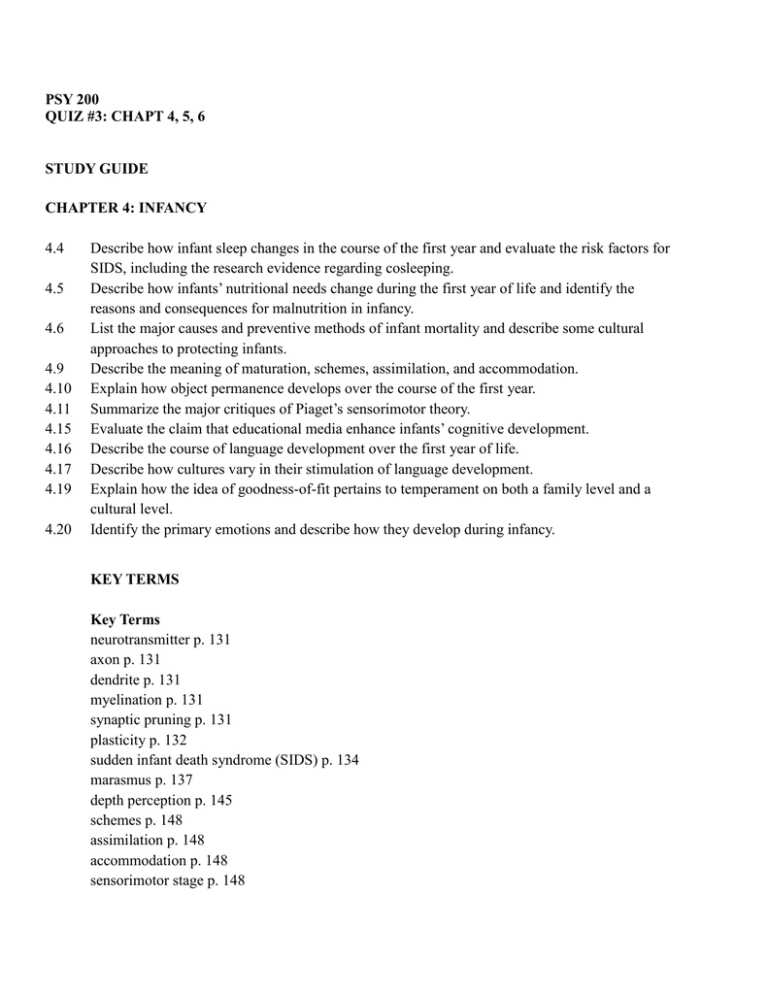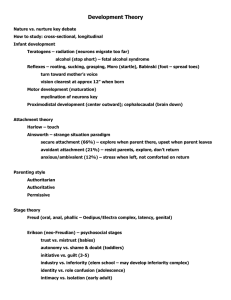PSY 200 QUIZ #3: CHAPT 4, 5, 6 STUDY GUIDE
advertisement

PSY 200 QUIZ #3: CHAPT 4, 5, 6 STUDY GUIDE CHAPTER 4: INFANCY 4.4 4.5 4.6 4.9 4.10 4.11 4.15 4.16 4.17 4.19 4.20 Describe how infant sleep changes in the course of the first year and evaluate the risk factors for SIDS, including the research evidence regarding cosleeping. Describe how infants’ nutritional needs change during the first year of life and identify the reasons and consequences for malnutrition in infancy. List the major causes and preventive methods of infant mortality and describe some cultural approaches to protecting infants. Describe the meaning of maturation, schemes, assimilation, and accommodation. Explain how object permanence develops over the course of the first year. Summarize the major critiques of Piaget’s sensorimotor theory. Evaluate the claim that educational media enhance infants’ cognitive development. Describe the course of language development over the first year of life. Describe how cultures vary in their stimulation of language development. Explain how the idea of goodness-of-fit pertains to temperament on both a family level and a cultural level. Identify the primary emotions and describe how they develop during infancy. KEY TERMS Key Terms neurotransmitter p. 131 axon p. 131 dendrite p. 131 myelination p. 131 synaptic pruning p. 131 plasticity p. 132 sudden infant death syndrome (SIDS) p. 134 marasmus p. 137 depth perception p. 145 schemes p. 148 assimilation p. 148 accommodation p. 148 sensorimotor stage p. 148 object permanence p. 149 information processing approach p. 151 habituation p. 152 dishabituation p. 152 goodness-of-fit p. 163 primary emotions p. 164 secondary emotions p. 164 emotional contagion p. 165 social referencing p. 166 trust-versus-mistrust p. 168 attachment theory p. 168 CHAPTER 5: TODDLERHOOD – YEARS 2 AND 3 5.7 Outline the cognitive achievements of toddlerhood in Piaget’s theory. 5.8 Explain Vygotsky’s sociocultural theory of cognitive development and contrast it with Piaget’s theory. 5.9 Summarize the evidence for the biological and evolutionary bases of language. 5.10 Describe the milestones in language development that take place during the toddler years. 5.11 Identify how parents’ stimulation of toddlers’ language varies across cultures and evaluate how these variations relate to language development. 5.15 Describe the essential features of attachment theory and identify the four classifications of attachment. 5.16 Identify the key factors influencing the quality of toddlers’ attachment to their mothers, and explain what effect attachment quality has on development. 5.17 Summarize the major critiques of attachment theory, including the cultural critique. 5.18 Compare and contrast the typical patterns of father involvement with infants and toddlers in traditional cultures and developed countries. 5.20 Identify the characteristics of autism and recognize how autism affects prospects for children as they grow to adulthood. 5.21 Identify the typical rates of television use in toddlerhood and explain some consequences of toddlers’ TV watching. KEY TERMS mental representations p. 187 zone of proximal development p. 190 private speech p. 190 scaffolding p. 190 holophrase p. 194 overextension p. 194 underextension p. 194 fast mapping p. 194 telegraphic speech p. 195 language acquisition device (LAD) p. 196 overregularization p. 196 autonomy versus shame and doubt p. 203 stranger anxiety p. 208 secure base p. 208 separation anxiety p. 208 Strange Situation p. 209 secure attachment p. 209 insecure–avoidant attachment p. 209 insecure–resistant attachment p. 209 disorganized–disoriented attachment p. 209 amae p. 215 polygyny p. 216 autism p. 220 CHAPTER 6: EARLY CHILDHOOD 6.3 Identify the main nutritional deficiencies and the primary sources of injury, illness, and mortality during early childhood in developed and developing countries. 6.5 Describe the development of handedness and identify the consequences and cultural views of left-handedness. 6.6 Explain the features of Piaget’s preoperational stage of cognitive development. 6.7 Explain what “theory of mind” is and the evidence for how it develops during early childhood. 6.9 Identify the features that are most important in preschool quality. 6.10 Describe the distinctive practices of Japanese preschools and how they reflect cultural values. 6.11 Describe early intervention programs and their outcomes. 6.13 Describe how children learn pragmatics in early childhood and identify to what extent these social rules are culturally based. 6.15 Describe moral development in early childhood, including empathy, modeling, and morality as cultural learning. 6.16 Describe the roles that parents and peers play in gender socialization and explain how gender schemas lead to self-socialization. 6.17 Describe the four types of parenting “styles” and the outcomes associated with each, and explain why those outcomes are complex. 6.18 Describe the major cultural variations in approaches to parenting. 6.19 Describe the main cultural variations in how parents discipline young children, and explain how cultural context influences children’s responses to discipline. 6.22 Identify the rates and consequences of media use in early childhood. KEY TERMS anemia p. 234 handedness p. 237 preoperational stage p. 240 conservation p. 241 centration p. 241 reversibility p. 242 egocentrism p. 242 animism p. 242 classification p. 242 theory of mind p. 243 sensitive period p. 250 externalizing problems p. 254 initiative vs. guilt p. 254 gender constancy p. 257 gender roles p. 257 gender schema p. 257 authoritative parents p. 259 authoritarian parents p. 260 permissive parents p. 260 time out p. 263 psychological control p. 263 corporal punishment p. 264 child maltreatment p. 265
